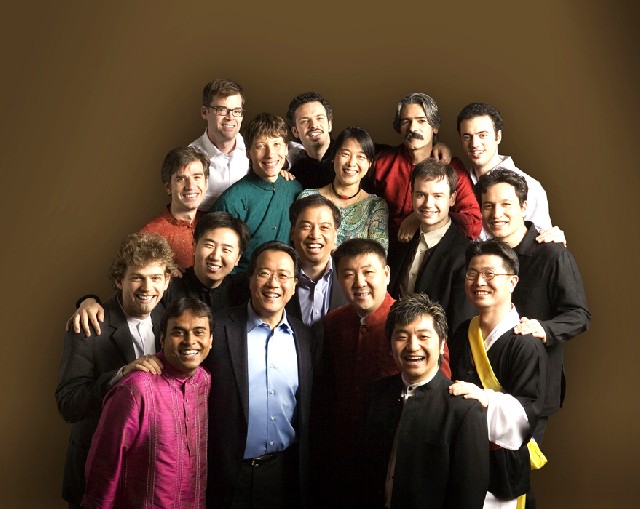Ma, Silk Road Ensemble offer a generous multicultural feast

Saturday’s return engagement of The Silk Road Ensemble at Symphony Center began quite rightly with the music. No talk, no explanations. Just a cheery wave from the charismatic Yo-Yo Ma to set the tone and the group of thirteen diverse and prodigiously talented musicians dug into their first offering, a Suite from John Zorn’s Book of Angels.
These four tunes by New York’s avant-garde maestro in colorful arrangements by members of the Ensemble proved a good choice. The music was varied and multicultural and a sympathetic listener could wallow in the superb musicianship without being overly troubled by who did what and where in the world the stunning sounds came from.
The suite was crossover at its most artful with Eastern instruments like the shakuhachi (Japanese bamboo flute), pipa (Chinese lute), sheng (a versatile Chinese mouth organ with vertical pipes) and variegated percussion pitted against a Western string ensemble consisting of violins, viola, cellos and double-bass. And when the piercing sound of the Spanish traditional bagpipe, the gaita, kicked in at the end, there was little left to be desired and the piece wrapped up in a grand finale with all musicians in glorious synch.
The rest of the program was almost anticlimactic after such a dynamic start, but even so there were plenty of fireworks and passionate solos to come. One of the most soulful turns came with Colin Jacobsen’s Atashga (Fire Temple). Played on the kamancheh, a traditional metal-stringed Persian fiddle, by the master Iranian musician Kayhan Kalhor and a smaller ensemble it featured the Western strings in a piece with almost waltz-like swaying rhythms and a quiet beauty.
The final work on the first half of the program, Playlist for an Extreme Occasion, a world premiere performance of a sequence of shorter jazz-inflected and highly percussive pieces, was written by New York-based jazz pianist and composer Vijay Iyer. The eight musicians on this occasion included pianist and gaita player Cristina Pato, tabla player Sandeep Das and Sheng player Wu Tong.
The last piece was the most ambitious, Sacred Signs: Concerto for Thirteen Musicians, by Uzbek composer Dmitri Yanov-Yanovsky. Presented in only its second public performance, the work took up the second half of the program with a sprawling 10-movement tribute to the 100th anniversary of the premiere of Stravinsky’s Rite of Spring. Each movement was dedicated to different members of the ensemble and the work was accompanied by a misty and atmospheric video projection that commented and at times enlarged on the music with starry skies, sunrises, rocky terrains, shadowy dancers and depictions of the original dance costumes used in the ballet.
Under the direction of conductor Eric Jacobsen, Stravinsky’s music was fleetingly referenced (not just the Rite, but also Petrushka and The Soldier’s Tale) but was hard to nail down and seemed mostly evinced by attitude and dynamics. The piece, which featured the shakuhachi of Kojiro Umezaki, the dexterous pipa of Wu Man, Kalhor’s soulful fiddle and the cellos of Mike Block, Eric Jacobsen and Ma as well as the bass of Jeffrey Beecher and the violins of Johnny Gandelsman and Colin Jacobsen, could have used some of Stravinsky’s concision and a few audience members were quietly leaving before the whole 35 to 40 minutes were over.
All the same the Silk Road Ensemble played beautifully and it was a pleasure to have them back in Chicago.
Posted in Performances




